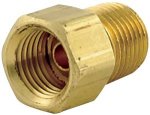Arawak
Chief Petty Officer
- Joined
- Aug 27, 2010
- Messages
- 486
Been fighting with a leaking connection on the bottom port of my Chrysler 105HP tilt trim valve body. The flare nut threads look fine and the end of the stainless steel line itself seems ok, so I replaced the VB but it still leaks under pressure right past the threads.
Any ideas on repair? Should I try to replace the line and if so is it the same thread as 3/16 brake lines?
Any ideas on repair? Should I try to replace the line and if so is it the same thread as 3/16 brake lines?




















